Oh my stars. Look at my new friend. I was recently the lucky recipient of this little guy, the final instar of a Spicebush Swallowtail caterpillar (Papilio troilus troilus). This gifting was related to my rapidly assuming the role and reputation of basically a crazy butterfly lady. An entomologist I am not, but I have learned a lot about butterflies and their dramatic lifestyle/cycle this week.
A caterpillar is born (hatched…). Maybe it is a moth-to-be. Maybe it is a butterfly caterpillar. Maybe it is a nocturnal, or Owl Caterpillar! I have discovered that the reason that I never saw a Zebra Swallowtail caterpillar even in a literal swamp full of Pawpaws and Zebra Swallowtail butterflies is because… they come out to eat at night! In the daytime they hang out hidden low around the tree somewhere. This explains at least one mystery. Now the baby caterpillar: before it was “born,” it was oviposited by its mama butterfly on the leaf of a plant that to the butterfly’s feet (which can smell!) had an odor reminiscent of her own favorite childhood foods. As you know, some of these friends are pickier than others. In this amazing wide-eyed guy’s case, its egg was probably laid on a Spicebush tree or a Sassafrass tree. Both of those are members of the sweet scented Lauraceae Tree family which I would love to talk to you about, or maybe just sit around scratching and sniffing together. But I am a distracted butter-mama living in what is quickly becoming a regular butt-house.
Unlike a lot of picky species, this one does not acquire a bad taste through its food. Instead it uses the age old trick of mimicry to avoid become some other picky or not so picky creeper’s dinner. It looks a lot like its cousin, the Pipevine Swallowtail, which, a little bird told me, is a yucky tasting caterpillar. It also looks, another bird said, a little like a snake. If you can find some Spicebush, what you should look for is a leaf that is rolled up. Although, contrary to popular belief, butterfly caterpillars do not spin cocoons out of silk (they make a chrysalis, doh!), most can produce some silky threads for various purposes. The Spicebush Swallowtail caterpillar likes to eat in the daytime. So do a lot of predators. In addition to trying to look like someone with a nasty taste, it also weaves little threads from edge-to-edge of leaves to roll the leaf up around itself, making it invisible. If a bird pokes its head in, the first thing it will see are big eyes on a green head. Not wanting to be eaten itself, the caterpillar hopes it will back away thinking it stumbled upon a snake.
The Spicebush Swallowtail is not “born” looking that way though. When it comes out of its egg it is tiny and brown with a little white. It looks actually almost exactly like a bird dropping. Not too many critters go around biting into poop on leaves so this is fairly protective. You can see one crawling around the bottom of the picture in the beginning of the video below. This caterpillar gets bigger, and eventually looks different too. Each stage that it goes through is called an instar. A caterpillar becomes a new instar by shedding its “skin,” or exoskeleton. It is an insect after all, which are invertebrates who wear their version of our backbone on the outside of their body. Lots of other dudes do this too, including the Maryland State Crustacean (Blue Crab). This means that the outside layer doesn’t grow with the creeper but is replaced usually many times. After the first few poop instars the Spicebush caterpillar sheds its skin again, starting at the top and finishing at the bottom, and reveals a whole new green snakey style! There are a few instars with this new look as well, and I could google how many but I am going to leave that one to you. I don’t know it first hand my friend came ready to pupate.
Here is a cute group photo from a Spicy Huffington Post article:
The guy in my picture is not green. When the time nears for him to shed his skin one more time and form a chrysalis, this Spicebush punky one turns a pretty orange color. Like my good friend, he often then is spotted wandering at a rapid pace far faster than my friends the Monarchs caterpillars can go. This one was hurrying around in a place of outdoor business (and plant growth) which lucky for him practices Integrated Pest Management. Meaning they do spray things with pesticides, womp womp, but they don’t spray if they can avoid it and still get people to buy shizz. The Spicebush sold there does not require spraying to look all pretty. Can I get another heck yes for the native plants? I am guessing that my friend grew up on one of them although maybe he wandered farther after starting out life in the forest. Not all who wander are lost. Some are searching for a spot to pupate.
Having little experience with this species, I was concerned when I received multiple voicemails about my gift item on hold. Still, I believe that captivity has some advantages for some creatures, particularly endangered ones vulnerable to predation and parasitism, and to human ones with curiosity and blogs. I hope to write more on this subject and the whole question of the dominion allegedly granted to us soon. The person who found my friend did some pretty wise googling, and already knew before I asked around that once orange our friend probably was, for the first time in his life, not hungry.
This guy settled by the time I got home on the bottom of the only available stick, above. Sorry that the photo is such poor quality, he did not choose with my camera in mind. The challenge of showing him off has been worsened by his opaque container. All the clear ones are currently occupied! He sat like this for a long time before spinning two “threads” from his midsection and hanging out for about 36 more hours.
While he appeared inactive, a lot was happening chemically. Again, I refer you to Google or possibly to a second Bachelor’s degree if you desire a molecular explanation. But trust. Invisible to us he was preparing a very important new body form that not even a plastic surgeon could help him switch up for the next little while. Besides, she might be faster, but what plastic surgeon can compare her before and after shots with a butterfly? Show me.
This morning our friend was gone. His skin was at the bottom of the opaque container looking only moderately creepy. He is a gorgeous chrysalis mofo.
You can also see the little web he made at the top of his stick to hold this precarious perch in place. He achieved his transformation in the privacy of the early morning hours. Nobody watching. But I found the following video that I think is the craziest thing I have ever seen. This one is FOR REALZ worth the click. It shows his real head (cause those eyespots are for show) poking out right before the exoskeleton comes off and the chrysalis is exposed. That’s what butterfly pupae (stage between caterpillar larvae and adult butterfly) are. Skin! Ok nitpickers, exoskeleton! That is the actual dude, not a thing with the dude in it. Sometimes it wiggles, especially right after it gets made, and it also grows and changes shape. Movement is also visible in the video!!
Check it out. The little bird poop early instar is in there too.
This chrysalis eventually is supposed to turn bright leafy green or twiggy brown. All for camouflage! Unlike the Monarch, this butterfly doesn’t migrate. To survive the winter, it remains in its chrysalis. They say, although they (meaning the internet) also dispute this, that over-winterers turn brown, while those butterflies planning to emerge and reproduce in the nice weather have green pupae. It’s all about the colors around you, as well as Google speculation. I guess I will know in two weeks (or 7 months) which way this will go My friend, altogether unrecognizable but the same inside (where it counts!) is still orange 12 hours after I discovered him in his new outfit. So he has some revelations yet up his sleeve.
Update: This one turned brown! Will he overwinter? Also, I don’t know why photos are smaller on WordPress when I add them later. Mysteries of html/finding the right button far beyond my grasp.
Update 2: Overwintering seems to be the plan: a chronicle of my friend’s winter freedom is here.
In case you are impatient, here is a photo of what will supposedly be coming out of that exoskeleton the next, and last, time:
Hi! You know me! I’m smaller than the other black butterflies you see around, and have noticeable orange and blue spots.
I leave you with a wish for the luck of a caterpillar: Keep your good parts, shed the no-longer-needed, and become your inner butterfly y’all.
And also with the Grumpy Old Man’s concession to this project: “They’re more interesting than tadpoles.” Note: tone implies this is not a glowing tadpole endorsement.

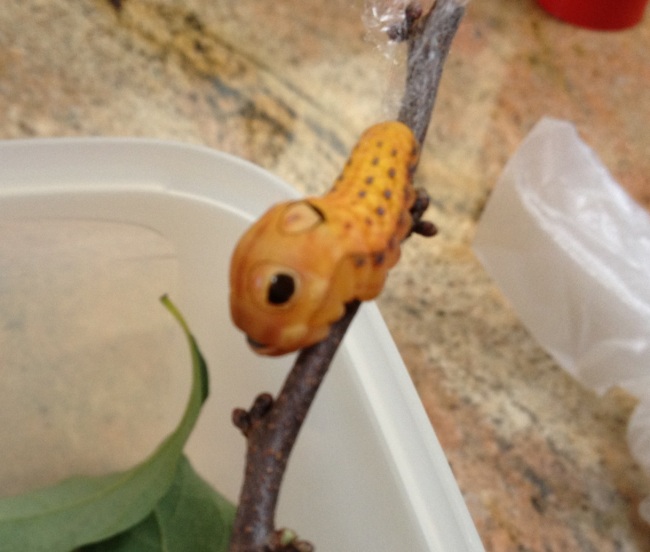
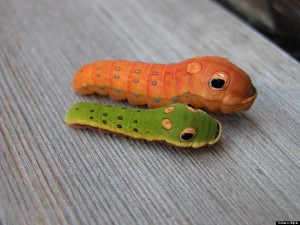
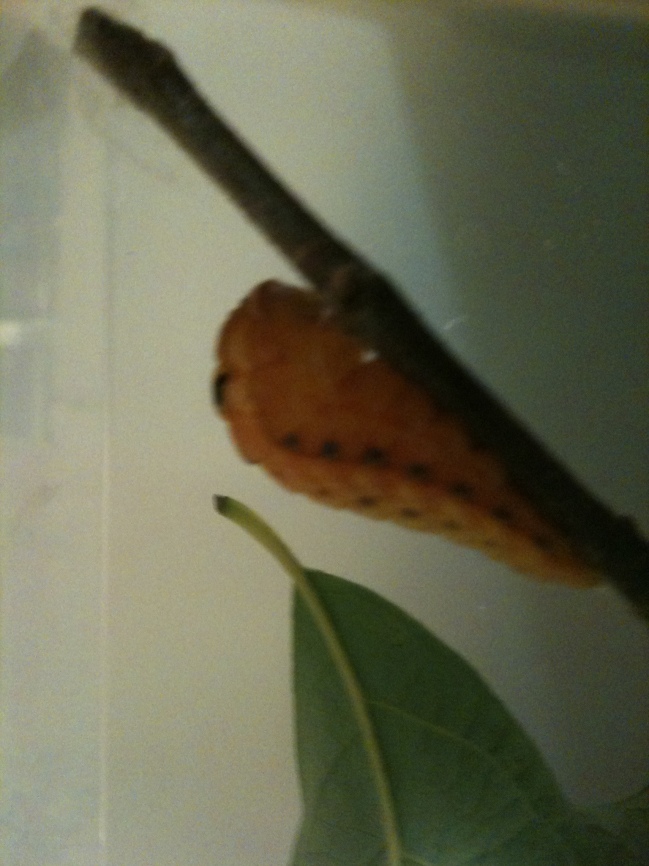
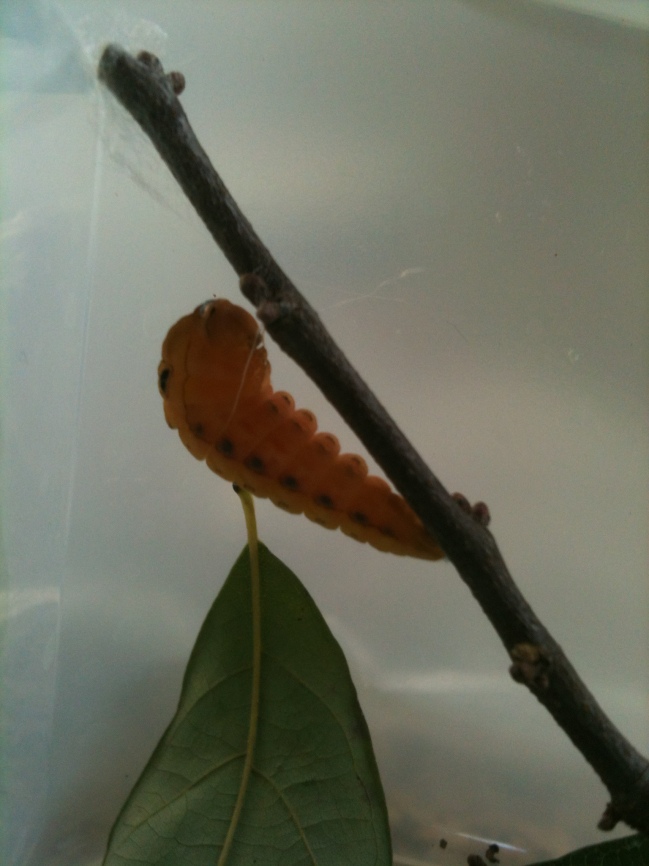
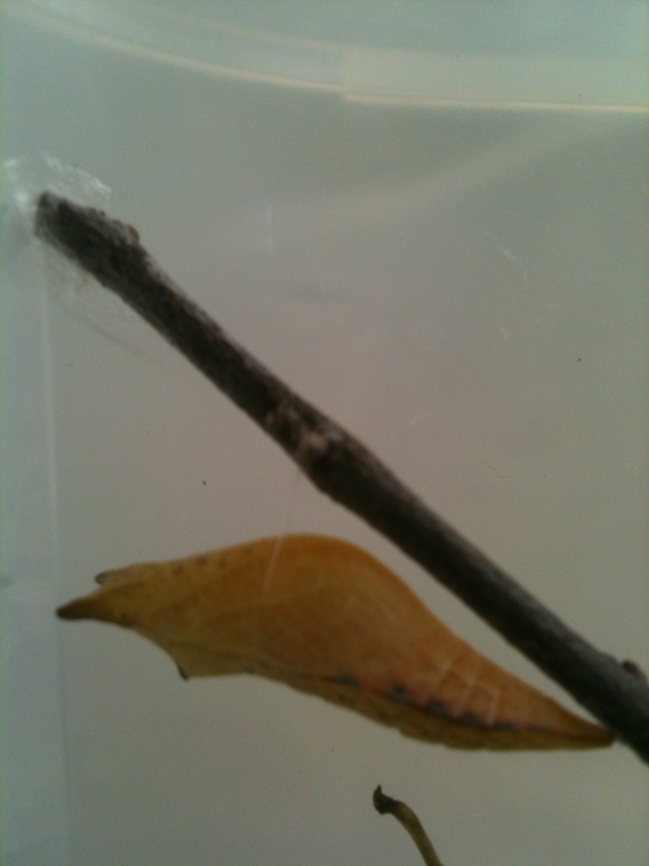
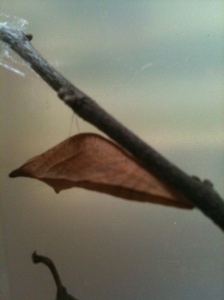
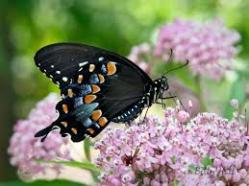







































Pingback: Forbidden Fruit | everycreepingthing
Pingback: Viceroy the Leaf | Photomiser
Pingback: Falling for Fall Color – Wildflowers | Hudson Valley Gardens
Pingback: Spicebush Swallowtail Chrysalis Moves Outside for Winter | everycreepingthing
Pingback: Autumn Cascade | everycreepingthing
Pingback: Trees Have Rights Too! | everycreepingthing
Pingback: 2013 in Nature Blogging | everycreepingthing
Pingback: Whoa Whoa Whoa, How Does a Black Swallowtail Caterpillar Grow? | everycreepingthing
Do you have your spicebush caterpillar on a specific type of stick? What kind of container are you keeping it in? One of my fellow teachers brought me an orange one and I want to let him crystalis in my classroom.
Hi Marcie! You may have already found out the answer by now… when Spicebush Swallowtail Caterpillars turn orange they are usually wandering around looking for a good place to pupate. Any stick should work, I think they like to have one at a bit of an angle. This one will probably stay in the chrysalis until the spring and then start a new generation next year! I was given the advice to keep the chrysalis outside, so it wouldn’t emerge too early. However when mine was outside it unfortunately got eaten. The next year I kept some Black Swallowtail chrysalises in my warm apartment all winter and they did not come out early, although I can’t promise that you would have the same experience. Enjoy!